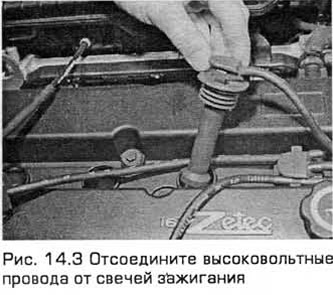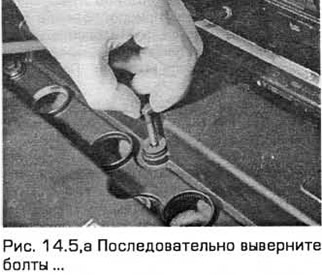Note. This procedure only applies to models manufactured after 05.199B. From this point on, Zetec engines were equipped with valves with hydraulic compensators.
Examination
1. Disconnect the negative battery cable. Remove the screw and disconnect the ground wire and hydraulic steering pipe bracket from the engine rear load lug. Move the pipe to the side (see fig. 14.1).

2. Turn out bolts of fastening of the top plastic cover of the gas distribution mechanism to a head of the block (see fig. 14.2).

3. Disconnect the high voltage wires from the spark plugs and move them to the side (see fig. 14.3).

4. Release the clamp and disconnect the positive crankcase ventilation hose from the head cover (see fig. 14.4).

5. Gradually loosen and remove the bolts, then remove the cover. Remove gasket (see fig. 14.5, a-c).



6. Set the engine to a position where cylinder #1 is at TDC. The cams of the intake and exhaust camshafts above cylinder No. 1 must be directed upwards (though not strictly vertical). Now you can measure the valve clearances.
7. Using a feeler gauge, measure the cam to shim clearance on each valve of cylinder #1 in turn (see fig. 14.7). Record the thickness of the probe. The regulated clearance values are given in the Technical data. Keep in mind that the intake and exhaust valve clearances are different. The intake camshaft is located at the rear of the engines, and the exhaust camshaft is located at the front. Write down all four gaps.

8. Rotate the crankshaft clockwise a half turn so that the cams above cylinder #3 are pointing up. In this position, measure and record the valve clearances of cylinder No. 3. The clearances for cylinders No. 2 and No. 4 can be measured by turning the crankshaft half a turn at a time, respectively.
Adjustment
9. If adjustment is necessary, press the pusher and replace the adjusting washer with a washer of a different thickness.
10. Before replacing the washer, the piston of the corresponding cylinder must be lowered and brought to a position displaced 1/4 turn clockwise from TDC. If this is not done, the piston will prevent the valve from moving when pressed, which may cause damage.
11. There is a special Ford tool for pressing the valves. It contains a bar bolted to the upper surface of the block head, and a lever with a ledge that rests against the edge of the pusher. To avoid damage, it is strongly recommended that you use such a tool and not a screwdriver or the like.
12. While pressing the pusher, remove the adjusting washer with a small screwdriver or magnet.
13. If the gap needs to be increased, then install a thinner washer. Install a thicker washer to reduce clearance. The thickness designation is engraved on the side of the washer opposite the camshaft. If it is not visible, then measure the thickness with a micrometer.
14. When the clearance and thickness of the washer to be replaced are known, the thickness of the new washer can be calculated according to the examples:
Gap needs to be increased
Required clearance
(A) = 0.15 mm
Measured clearance
(B) = 0.09 mm
Replaceable washer thickness
(C) = 2.55 mm
Thickness of required washer
(D) 1 C + B - A = 2.49 mm
Gap needs to be reduced
Required clearance
(A) = 0.30 mm
Measured clearance
(B) = 0.36 mm
Replaceable washer thickness
(C) = 2.19 mm
Thickness of required washer
(D) = C + B - A = 2.25 mm
15. After installing the washer of the required thickness, release the device for pressing the pusher. Rotate the crankshaft. so that the camshaft lobes point upwards again. Check gaps.
16. Repeat the procedure for the remaining valves, turning the crankshaft accordingly.
17. It is useful to keep a record of the thicknesses of the shims for each cylinder.
18. It is allowed to reinstall the washers from one pusher to another to achieve the required clearance. But it is not recommended to rotate the camshaft when any shims are removed.
19. After reaching the required clearances, remove the tool and install the block head cover with a new gasket (if necessary). Connect the positive crankcase ventilation hose and high voltage wires. Install the timing cover and tighten its bolts. Connect the negative battery cable.
Visitor comments